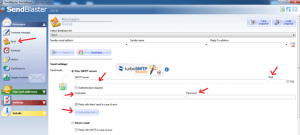Your Business Needs Comprehensive Online Backup, Yesterday – Here’s Why
You don’t leave home without locking the door. Why would you leave your organization’s most sensitive secrets vulnerable to entirely preventable data loss or corruption?
You wouldn’t — well, you shouldn’t. That’s why you’ve invested in a comprehensive online backup system that ensures your organization’s operational and archived data are protected from come what may.
What’s that? You haven’t invested in a comprehensive online backup system? You stand to lose irreplaceable data at any moment?
Join the club. Countless otherwise well-run organizations have yet to invest in one of the most basic digital security functions around: a diversified, dispersed online backup architecture that mitigates the downside risk of a temporary system crash or failure.
That you’re in good company doesn’t mean you should delay your backup plans any longer. Indeed, you should pursue them with all haste.

If you need to sell them to the board or CTO first, though, you’ll want to have your talking points in order. Let’s run through more than a dozen of the most compelling reasons to deploy a comprehensive online backup system at your earliest convenience. Your betters will surely find a few of these to be compelling.
1:- You Can’t Control the Weather
A quick glance at a map of current U.S. weather hazard warnings reveals that, yes, there’s always weather happening somewhere. What that weather looks like depends on season, location, and a host of other factors too boring to get into here.
What’s important to understand about the weather is a) you can’t control it, and b) if it’s severe enough, it could threaten the physical infrastructure on which your data is stored. A direct hit by a hurricane, or even a thunderstorm severe enough to spawn tornadoes or hurricane-force straight line winds, could devastate your home office — along with the servers in the basement.
And if you’re fortunate enough to live in a place blessed with mild weather — hello, SoCal! — you’re surely vulnerable to perils not caused by soggy storm systems. Wildfires, earthquakes — the threat is real, and your data is at risk.
2:- You Can’t Completely Defend Against Malicious Insiders…
CA Technologies’ most recent Insider Threat Report surfaces some alarming statistics. To wit: “A majority of 53% confirmed insider attacks against their organization in the previous 12 months (typically less than five attacks),” the report reads, and “[t]wenty-seven percent of organizations say insider attacks have become more frequent.”
Yikes. Would you bet it all on a coin flip?
No, you wouldn’t. And you shouldn’t. Trust isn’t the issue here; the sad truth is that you can never truly know what’s in another person’s heart. Or what a competitor is offering them to make off with your crown jewels.
3:- …Or Careless Insiders, for That Matter
Not all insiders are malicious. A great deal of preventable data loss turns on a lost laptop or external hard drive — the stuff of farce, not spy novels. Without a comprehensive backup regime, all it takes is one inept employee leaving one critical storage device in an airport or train station to wreak havoc on your organization’s security posture.
Yes, of course you can fire the incompetent. But that won’t bring your data back from…wherever it is, will it?
4:- Single-Point Data Storage Is Vulnerable to Lengthy Disruption
So, where is your data stored, anyway?
If you’re running off a single server farm in the basement of your home office, you’re vulnerable to the sorts of disruption that will happen eventually, given enough time. Perhaps it’ll be a brownout on the hottest day of the year, or a careless flip of the circuit breaker, or a freak power surge that the power company can’t explain.
However it happens, whenever it happens, the result is the same: your system is down, your un-backed-up data lost to the wind. Or, if you’re fortunate enough to come out on the other end with your data intact, inaccessible for as long as it takes to address the problem.
Remote, cloud-based backup solves the single-point problem. As we’ll see in a moment, you’re not the only one for whom this matters.
5:- Even a Short Outage Could Result in Significant Data Loss
About that outage that definitely will happen, given enough time: no matter the duration, it’s all but certain to wipe out operational data that hasn’t been backed up to the cloud or an external storage device.
Depending on the nature of your operation and the regulatory requirements to which you’re held (more on those below), you may need to back up your data multiple times per day. Even a temporary outage that hampers regularly scheduled updates could result in significant data loss or put your organization in conflict with your industry’s rules of the road.
6:- Your Operational Needs Don’t Stop When Your System Goes Down…
More to the point, even temporary outages hamper your organization’s internal operational needs. Business doesn’t wait until you’ve fixed the problem and regained full access to your uncorrupted data. Your organization needs to be on and available on a 24/7 basic, or at least when it says it’s going to be.
7:- …And Neither Do Your Clients’
Indeed, your organization needs to be available “when it says it’s going to be” because your word is your bond — and because your clients take it to the bank.
Deferring your own internal operational needs is serious enough. Telling your clients that you simply can’t address their needs at this particular time is unforgivable. Any client to which you’re compelled to break that news would be well within their rights to shop around for a new vendor.
You can’t afford that. You shouldn’t accept that. And you’re not going to allow that. The solution is clear: you need a backup solution that eliminates downtime and reduces the risk of unforgivable service lapses.
8:- Ransomware Can Strike at Any Time, Anywhere…
You’ve probably heard about ransomware, an increasingly common form of malware that locks victims out of their own systems until they pay a ransom.
For larger organizations, it’s not the ransom that’s the issue. Run-of-the-mill ransomware attacks typically ask for the equivalent of a few hundred dollars (“equivalent” because we’re talking about purportedly untraceable cryptocurrency here) per device. That’s not necessarily ruinous — although, for smaller organizations running on thin margins, it’s a very different story indeed.
No, the most serious threat from ransomware is the risk of catastrophic data loss or corruption. If you’re unable or unwilling to pay the ransom, you’re simply not going to get your data back — and, if that data isn’t properly backed up, it’s going to be gone forever.
Even if you do pay the ransom, there’s no guarantee you’ll get your data back in uncorrupted form. These are cybercriminals you’re dealing with, not Scouts — they’re not bound by their honor. In many cases, ransomware programs simply take their ransoms and run.
If and when that happens, you’re not just on the hook for the ransom. You’ll also need to replace your hardware.
9:- …As Can Other Types of Crippling Malware Attacks
Ransomware isn’t the only type of malware to worry about, of course. CSO identifies eight types of malware that could affect your organization’s systems and operations, including:
- Viruses, which modify files on the host computer and can be particularly difficult to eradicate (or even detect)
- Worms, which “burrow” into host systems and self-replicated (infecting other machines) without any action on the end-user’s part
- Trojans, which — like the original Trojan horse — disguise their malicious nature behind seemingly legitimate fronts and work by convincing the end-user to execute them
- Fileless malware, which share characteristics with the three forms above but doesn’t need a discrete file to spread or do its work
- Adware, which expose the user to potentially malicious or spammy advertising
- Spyware, which may log keystrokes or other end-user information and can be absolutely devastating for organizations with sensitive data to protect
10:- Your Organization May Be on Sophisticated Attackers’ Target Lists (And You May Not Know It Until It’s Too Late)
Earlier this decade, Sony Pictures was hit by an embarrassing and highly sophisticated hack that was eventually traced back to hackers working for North Korea’s authoritarian government.
As this Slate piece makes clear, it’s extremely difficult to deter nation-state hackers like these — if they want into your system, they’re going to get in, one way or another. If you can’t affirmatively protect yourself against these types of hacks, the next best thing to do is invest in mitigation: ergo, cloud backup.
11:- You May Need to Comply With Multiple Recordkeeping Regimes…
Your organization is almost certainly bound by multiple recordkeeping regimes. Every incorporated entity, including nonprofits not subject to state or federal tax, must keep detailed financial records for the benefit of revenue authorities. Entities operating in certain industries or professions, such as legal services, have binding legal obligations to keep client records stretching back many years.
We could go on. The point is, any threat to the sanctity of your archived data is a threat to your organization’s compliance with applicable law — violation of which could pose an existential risk to its continued existence.
12:- …Some of Which May Be Retroactive
Data archiving requirements aren’t always forward-looking. New regulatory regimes, such as California’s consumer privacy scheme, may cover data collected months or years prior — data that, if not properly collected and stored, could expose your organization and/or key employees to civil or criminal penalties.
13:- Your Clients Demand (and Deserve) Peace of Mind
We’ve already touched on the operational threat of interrupted access to sensitive data or secure backend systems, but your clients aren’t solely worried about the day-to-day. They’re also rightly concerned with the security of the data that you collect, store, and transmit on their behalf — data that cannot be allowed to fall into the wrong hands.
These clients might be consumers; blockbuster data breaches affecting Target and Home Depot exposed millions of individuals’ credit card numbers and bits of personally identifiable information. That doesn’t change your obligation to shield those who reward you with their business.
14:- You May Need to Prove Your Backup Bona Fides to Win New Business
If you’re trying to win new business from enterprise clients — and especially publicly traded firms, government contractors, and businesses operating in highly regulated industries — then you already know you’re going to have to jump through a slew of hoops just to get in the door.
Data hygiene is one of those hoops. If you can’t prove that you take digital security seriously, and that you have a comprehensive plan in place to mitigate data breaches and loss, you’re simply not going to close that deal.
15:- BYOD Just Isn’t Feasible Without Comprehensive Online Backup
You’ve almost certainly embraced the BYOD revolution. If your move to BYOD didn’t correspond with a wholesale investment in cloud backup, you’re not doing right by your team (or your clients).
Let’s be clear: From a security standpoint, BYOD is simply not feasible without a comprehensive online backup architecture. It only takes one lost or compromised device to poke a hole in your security posture and loose the demons to which we’ve already alluded.
Invest in Online Backup Today — Before You Wish You’d Done It Sooner
You can’t predict when disaster will strike. If you could, you wouldn’t have read this far. You wouldn’t be reading this at all, actually — you’d be sitting on a beach, sipping a tasty frozen beverage paid for from a bottomless bank account.
Ah, to dream.
Back here in the real world, you and your fellow mortals need to take proactive measures to protect against come what may. Investing in a comprehensive online backup architecture is among the simplest, most straightforward, lowest-risk of these measures. And you can get started today.
You should, too. That sense of urgency you feel after reading through all the reasons to protect your data isn’t just your paranoia getting the better of you — it’s a rational reaction to the plethora of potentially existential threats you face every day in an increasingly digital world.
So, dispense with the excuses. Enough with the delays. It’s time to take control of your data, and it starts with an online backup system that does you proud.








